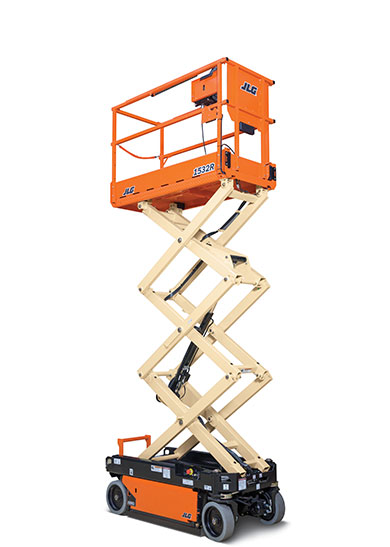If you work in a warehouse, chances are you’ve seen a warehouse access platform.
These sturdy elevated platforms allow workers in all sorts of industries the ability to quickly, easily and safely access items at height, without the need for costly machinery or dangerous ladders.
You may be wondering which lift type access platform is right for your business. In this article, we provide an overview of access platforms for warehouses, including the types of access platforms available, and where each one might be used.
What is a warehouse access platform?
A warehouse access platform offers colleagues in warehouses and other industrial-type settings an elevated stage to reach materials, products and other items that are located at high levels. These portable platforms provide support, stability and safety when both manoeuvring and ascending, and are perfect for use during building renovations and performing warehouse inventory work.
There are lots of different warehouse access platforms available, from snappy towers to cherry pickers, each designed with a specific set of jobs in mind. Smaller warehouse access platforms will likely feature sturdy metal steps, a handrail and hand-operated levers, and are mobile thanks to castors at both ends.
The good news is that they come in a variety of shapes and sizes, so no matter your requirements, there is likely a warehouse access platform that meets your needs.
What are the benefits of access platforms?
The main benefit of a warehouse access platform is that it allows operatives to reach items at height, safely and securely.
Most warehouse access platforms include safety features such as handrails and enclosures, to ensure the worker can concentrate on the job, and not on the platform itself.
All industrial access platforms will be made from the most robust materials available, to ensure that both workers and any materials are safe from harm.
Another key benefit is that most access platforms are completely mobile, too. You’ll find that smaller platforms will come with castors, while the heavy-duty industrial options may be machine or even motor operated. This allows the operative to quickly and safely move the platform between jobs, without the need to dismantle the equipment.
What types of access platforms are there?
There are dozens of access platforms to choose from, to selecting the right one can feel a little overwhelming at first.
Below we’ve listed the most popular types of access platform, and what each type might be used for.
Semi-stationary platforms
The most commonly recognisable access platform, the semi-stationary platform is constructed from steel poles welded together to provide an extremely sturdy area in which to work at height. Because these access platforms are designed to be used at a significant height, you will likely find guard rails or enclosures as part of the design.
Semi-stationary platforms are perfect for workers regularly working at heights for longer periods of time. They’re more robust than traditional access platforms, and while they are mobile, are more difficult to move thanks to their heavy-duty design.
Snappy towers
Snappy towers offer the same elevation as a step ladder, however, are far more stable thanks to a flat, level platform at the centre of the tower. They provide a large working area, so are great for working at height – painters, decorators and carpenters are typical users of snappy tower platforms. Thanks to this sturdy design, snappy towers can support substantial weights.
Most snappy towers are foldable, so despite their robust design, are easy to transport to and from the job. They’re generally closer to the ground than traditional access platforms and include guard rails for an added level of safety.
Powered access platforms
Also known as cherry pickers, scissor lifts or boom lifts, powered access platforms are ideal for working at a significant height. They start at ground level and feature a sturdy, enclosed platform that ascends with power. Operatives can determine the exact height they want to go to, thanks to a hydraulic lift operated from inside the platform enclosure.
Scissor lifts are slightly different to cherry pickers in that they feature two motorised scissor supports, allowing the operative to ascend and descend directly upwards, making them a great choice for window cleaners and other such tasks.
Cherry pickers, or boom lifts, work in a similar way but offer a far greater range of movement. they’re not limited to vertical travel, so can be moved in a range of directions, making them more useful for a wide variety of jobs. Cherry pickers are typically used for large construction projects.
Tread model access platforms
Designed for smaller spaces such as schools, supermarkets, offices and on house renovation jobs, tread model access platforms are smaller in size and feature a set of steps on wheels. They’re often narrow in design, making them a fantastic choice for use in corridors, hallways and aisles.
Tread models come in different sizes but typically are seen to have 3, 4 or 5 steps leading to a stage in which to perform work. Like other industrial access platforms, tread models will feature a guard rail to ensure safe working at height, heavy-duty castors and brakes, to ensure the equipment is stationary at all times. Some tread model platforms include double access, allowing workers to ascend from both sides.
When you should use an access platform
Warehouse access platforms are designed for a variety of uses. In most cases, these elevated platforms are used in industrial warehouse settings, allowing operatives a quick and safe way to access hard to reach items without the need for a ladder.
Just like a step ladder, access platforms are ideal for use in homes, commercial premises and industrial locations, and come in a wide variety of shapes and sizes depending on the job at hand. Mobile safety steps are a vital piece of warehouse equipment in many professional settings, such as parks, concert venues, supermarkets, shopping centres, storage units, hospitals and even airports.
Access platforms should be used when a traditional step ladder is either too small or not strong enough for the job. Industrial style warehouse access platforms are specifically engineered to carry substantial weights, making them a far safer option than traditional, unfixed ladders. They’re suitable for lone working, too, thanks to their safe and sturdy design.
They’re also a fantastic option if you need to move your platform around with ease. Almost all access platforms are designed for easy mobility and are usually fitted with industrial-strength castors at either end. Once you’ve got your platform into position, secure it in place with the castors’ heavy-duty brakes before you ascend. Some larger access platforms like scissor lifts may feature a motor – these are typically used on construction sites where plant machinery is in operation.
What sorts of industries use access platforms? Is an access platform right for my business?
Because access platforms come in a range of sizes and elevations, they make a perfect solution for many businesses. Most commonly, access platforms are used by warehouse operatives who have to maintain large inventories of stock or are regularly moving large boxes around. Access platforms are safe to use thanks to their heavy-duty wheels and brakes, so are excellent for professional environments where colleagues regularly need to climb up to reach their items.
Access platforms are also used by home renovation experts, from painters and builders to carpenters and electricians. Maintenance staff choose access platforms to carry out repairs in places such as parks, sports centres, airports and venues, some smaller access platforms are also used in schools, to carry out maintenance work and to install displays.
If you’re wondering whether a mobile access platform is right for your business, we recommend carrying out a few simple checks before purchasing. Firstly, you’ll need to measure the space in which the platform will be operating – its no good having a great big industrial style platform for a small space, where manoeuvring could be both difficult and dangerous. Make sure the there is at least a foot’s room on either side of the platform for safe operation. Next, you’ll need to measure the height at which your items are kept. There are access platforms of three, four, five and even six feet, so you’ll need to make sure your platform is at the right height to do the job safely.
What are the benefits of cherry pickers?
if you’re considering using a cherry picker for your job, it may be useful to weigh up your requirements before taking the plunge. A cherry picker is a sophisticated piece of machinery and therefore comes with a hefty price tag. That said, they’re one of the safest access platforms available and are suitable for a huge variety of uses thanks to both vertical and horizontal travel.
The main benefit of a cherry picker is that it allows the operative to be very precise in height and placement – the position of the platform is determined by levers operated from within the cab (or within the base unit, depending on the type of cherry picker you’re using), which makes it a great choice for construction workers.
Cherry pickers are usually reserved for large scale construction jobs.
Ready to choose your warehouse access platform?
If you’re looking for a quality warehouse access platform, or perhaps need a little guidance in choosing the right platform for the job, give us a call today. Our team of friendly and knowledgeable mobile access platform experts will be on hand to guide you through the entire process, and answer any questions you may have.


